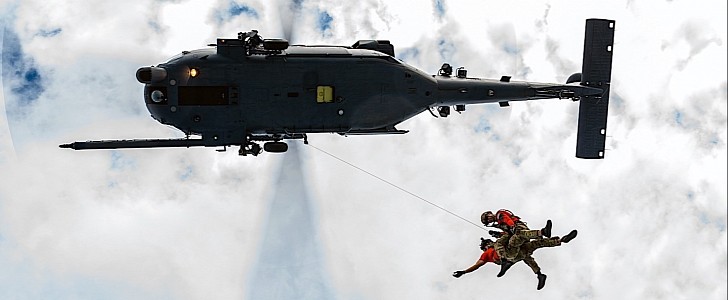We’re not sure how many of you now reading this have had the opportunity of dangling underneath a perfectly good aircraft (we certainly didn’t), but it must be quite the sensation. And such an activity would probably be a perfect addition to next year’s bucket list.
To give us civilians a taste of how dangling underneath a flying helicopter is, the U.S. Air Force (USAF) likes to show us from time to time that in stunning images of its forces (and machines) in action.
Back in October, for instance, we got to see a couple of U.S. Marines seemingly hugging each other on their way down from a hovering HH-60G Pave Hawk. That looked like some serious business, whereas the one we have here, depicting two pararescuemen deployed with the 31st Rescue Squadron, seems equally serious and dangerous, but kind of fun at the same time.
Based at Kadena Air Base in Japan, the 31st Rescue Squadron came to be in 1952 with the purpose of making sure “anyone in need of medical care, regardless of the location or situation, will make it out safe and sound.” The unit was involved in several high-profile operations through Southeast Asia over the years, including the famous rescue of the soccer team that was trapped for 18 days in a flooded cave in Thailand back in 2018.
Seen here dangling under the same type of aircraft as the Marines, the two members of the unit were captured on film back in November, during something the USAF calls hoist operations – no other details on the mission were given.
The machine chosen as a support platform, the Pave Hawk, is one of the favorite workhorses of the American military. Although on its way out the door, with its replacement in the making, the Pave Hawk is still proving extremely reliable. Born in the 1980s, the twin-engine helo can take off weighing as much as 22,000 pounds (9,900 kg), then travel through the air at speeds that can reach 184 mph (296 kph).
At the time of writing, there are just under 70 HH-60G Pave Hawks in operation, so we’ll take any image of it we get before it exits the scene.
Back in October, for instance, we got to see a couple of U.S. Marines seemingly hugging each other on their way down from a hovering HH-60G Pave Hawk. That looked like some serious business, whereas the one we have here, depicting two pararescuemen deployed with the 31st Rescue Squadron, seems equally serious and dangerous, but kind of fun at the same time.
Based at Kadena Air Base in Japan, the 31st Rescue Squadron came to be in 1952 with the purpose of making sure “anyone in need of medical care, regardless of the location or situation, will make it out safe and sound.” The unit was involved in several high-profile operations through Southeast Asia over the years, including the famous rescue of the soccer team that was trapped for 18 days in a flooded cave in Thailand back in 2018.
Seen here dangling under the same type of aircraft as the Marines, the two members of the unit were captured on film back in November, during something the USAF calls hoist operations – no other details on the mission were given.
The machine chosen as a support platform, the Pave Hawk, is one of the favorite workhorses of the American military. Although on its way out the door, with its replacement in the making, the Pave Hawk is still proving extremely reliable. Born in the 1980s, the twin-engine helo can take off weighing as much as 22,000 pounds (9,900 kg), then travel through the air at speeds that can reach 184 mph (296 kph).
At the time of writing, there are just under 70 HH-60G Pave Hawks in operation, so we’ll take any image of it we get before it exits the scene.












